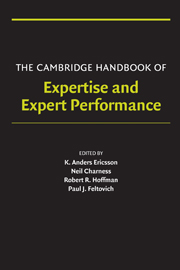Book contents
- Frontmatter
- Contents
- Acknowledgments
- Contributors
- PART I INTRODUCTION AND PERSPECTIVE
- PART II OVERVIEW OF APPROACHES TO THE STUDY OF EXPERTISE – BRIEF HISTORICAL ACCOUNTS OF THEORIES AND METHODS
- PART III METHODS FOR STUDYING THE STRUCTURE OF EXPERTISE
- PART IV METHODS FOR STUDYING THE ACQUISITION AND MAINTENANCE OF EXPERTISE
- PART V DOMAINS OF EXPERTISE
- PART V.A PROFESSIONAL DOMAINS
- PART V.B ARTS, SPORTS, & MOTOR SKILLS
- 26 Music
- 27 Expert Performance in Sport: A Cognitive Perspective
- 28 Artistic Performance: Acting, Ballet, and Contemporary Dance
- 29 Perceptual-Motor Expertise
- PART V.C GAMES AND OTHER TYPES OF EXPERTISE
- PART VI GENERALIZABLE MECHANISMS MEDIATING EXPERTISE AND GENERAL ISSUES
- Author Index
- Subject Index
- References
28 - Artistic Performance: Acting, Ballet, and Contemporary Dance
from PART V.B - ARTS, SPORTS, & MOTOR SKILLS
- Frontmatter
- Contents
- Acknowledgments
- Contributors
- PART I INTRODUCTION AND PERSPECTIVE
- PART II OVERVIEW OF APPROACHES TO THE STUDY OF EXPERTISE – BRIEF HISTORICAL ACCOUNTS OF THEORIES AND METHODS
- PART III METHODS FOR STUDYING THE STRUCTURE OF EXPERTISE
- PART IV METHODS FOR STUDYING THE ACQUISITION AND MAINTENANCE OF EXPERTISE
- PART V DOMAINS OF EXPERTISE
- PART V.A PROFESSIONAL DOMAINS
- PART V.B ARTS, SPORTS, & MOTOR SKILLS
- 26 Music
- 27 Expert Performance in Sport: A Cognitive Perspective
- 28 Artistic Performance: Acting, Ballet, and Contemporary Dance
- 29 Perceptual-Motor Expertise
- PART V.C GAMES AND OTHER TYPES OF EXPERTISE
- PART VI GENERALIZABLE MECHANISMS MEDIATING EXPERTISE AND GENERAL ISSUES
- Author Index
- Subject Index
- References
Summary
Acting
History
As an art form, acting dates back well over 2,500 years. Large choruses that performed dance-chant rituals called dithyrambs toured the Greek countryside celebrating the birth of Dionysus, god of wine and fertility. Some historians (e.g., Brockett, 1991) suggest that, although these group presentations sowed the seeds of theatre, only when a dithyramb leader named Thespis stepped forward and talked to members of his chorus (not as himself but as a character in the drama) did the art of theatre truly begin. Soon, writers contributed original dialogue to these presentations, and yearly competitions between dithyrambic groups were held in Athens at a 15,000-seat amphitheatre built for the purpose. Thus, the golden age of dramatic art was launched, showcasing the works of Aeschylus, Sophocles, Euripides, and Aristophanes.
When the Romans conquered Greece, playwrights such as Plautus and Terrance based most of their works on Greek models but made them far earthier, as they had to compete with such entertainments as gladiators fighting to the death and humans being fed to the lions. After the Romans, theatre more or less vanished until revived many centuries later by the Church for teaching religious principles (Cohen, 1994). The resulting awakening of public interest led to the Renaissance playwrights, most notably Shakespeare, who, in Hamlet's advice to the players, presented to all future generations the hallmarks of good acting: “… o'erstep not the modesty of nature. For anything so o'erdone is from the purpose of playing whose end was and is to hold, as 'twere, the mirror up to nature” (Shakespeare, 1604/1992 p.137).
- Type
- Chapter
- Information
- The Cambridge Handbook of Expertise and Expert Performance , pp. 489 - 504Publisher: Cambridge University PressPrint publication year: 2006
References
- 15
- Cited by

